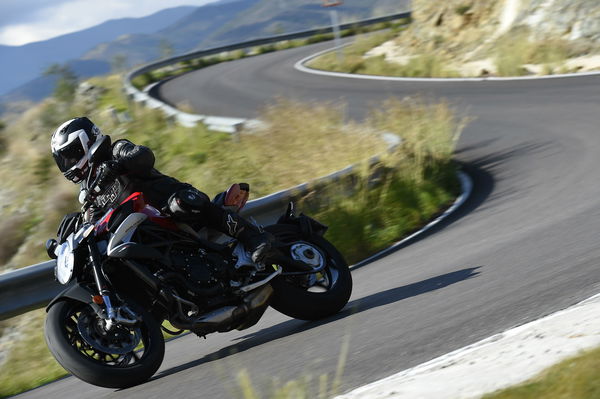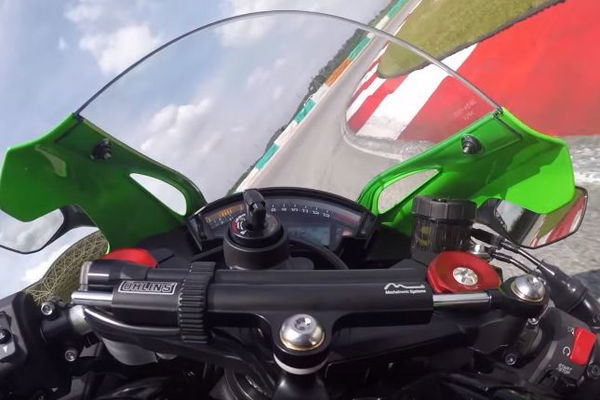First ride: MV Agusta Brutale 800 review
Peak power may be slightly down but the Brutale 800 now has torque wherever you look and an electronics package to make the most of it


MORE power, less weight. Those are the traditional headline claims every time a bike is updated, aren’t they?
Not this time. MV Agusta has broken with tradition by making the new Brutale 800 less powerful than the old one, at 116hp compared to 125.
Peake torque is up, but only a bit, at 61lbft compared to 57.8. And it’s a little heavier, at a claimed 172kg dry compared to 167.
That's not the whole story of course. Less power and more weight isn’t a new MV strategy. The firm hasn’t made ‘heavier and slower’ its new company mission.
A peak is only useful at one particular rpm and most of the time we have the needle somewhere else, MV argues. So instead of focusing on peaks, they've improved all those other rpm, where we do spend nearly all our time.
The maximum of 67lbft lies at 7,600rpm but the latest version of the 798cc triple engine is claimed to make at least 90% of that (60lbft or more) everywhere from 5,000rpm to the red line, at around 12,000.
So while the peak is only up by about 3lbft, the increase in the low-to-mid-range is up to 18% according to MV.
A range of engine revisions and a bulky new exhaust have also made the Brutale 800 Euro4 compliant, possibly explaining the motive for updating the model.
In terms of torque, it's the same philosophy that MV adopted with the 110hp Turismo Veloce, with which the Butale shares its engine: swap power which you don't usually use for torque that's always to hand.
It gives the Brutale 800 the same capacity for making leisurely work of a good pace, but in a lighter and more compact package.
The engine makes a distinctive raspy noise which rises several decibels and takes on a note of induction above 5,000rpm. There is enough drive anywhere from there to the red line to accelerate with gratifying urgency. The Brutale 800 isn’t ludicrously fast but it's always ready to respond.
The spread is sufficiently broad that you hardly need to wait for the revs to get near the 12,000rpm red line before changing up. When you do hold out there's a satisfying, linear build - nothing too dramatic because you're already getting most of it. When you don't hold out, you still get another shovel-load as you knock it up gear.
And knocking the selector with your foot is all you have to do. As well as engine tweaks, the Brutale 800 has a new electronics package including traction control, riding modes, a hydraulic slipper clutch and a quick-shifter.
It allows clutch-less shifts up and down the box, provided you've got the throttle closed on the way down and open on the way up. You've also got to be doing over 12mph - which you will be.
Downshifts are so smooth you'd barely know about them until you opened the throttle again. With a pillion, it will mean less banging heads and a less stressful experience of sitting on that perch-like seat over the rear wheel, clinging to the discreet grab rail.
Without a pillion, it ensures the bike remains settled as you brake for a corner, even if your gear changes are badly timed.
MV chose a good place to show the strengths of the torque and quick-shifter by launching the bike with a ride on the famous Ronda road near Malaga.
It's like a line drawn on the map with a shaky hand, a sequence of bend after fast bend that stretches on until your arms ache from the acceleration and braking forces through the bars.
On the Brutale 800 those forces are relentless but otherwise the work is light, with barely a pause in drive on clutch-less up-shifts, torque wherever you look and a ferociously powerful front brake.
The twin four-pot Brembo radial calipers make one of those set-ups that take a bit of recalibration. Grab the lever like you're on a lesser bike and you're in for a surprise. After a moment of adjustment to their immediate bite, and the delicate touch required, they provide cartloads of controllable stopping force in return for little effort
The rear brake, with a two-piston Brembo caliper, doesn't deliver comparable control or connection, although it has power.
ABS can be switched off using a couple of buttons on the left bar, accessing a menu on the digital dash which also lets you choose between traction control levels zero to eight. You can switch the quick-shifter off too, if you want to use the hydraulic slipper clutch instead.
On the right bar, another button lets you choose between riding modes. There are three pre-set modes - Sport, Normal and Rain, each with its own fuel map, offering a different torque response to a given twist of the ride-by-wire throttle. A fourth mode is customisable.











